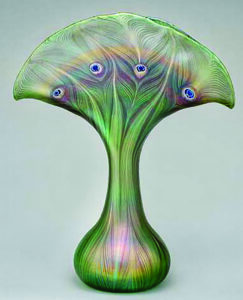(Editor’s note: DeeDee Wood is the owner of Black Cat Curiosities, an online antiques research and sales venue.)
I was looking through some antique books the other day, when I came across flowers and spring, which led me to Tiffany glass panels with daffodils, which led me down the path to studying Favrile glass.
What was Louis Comfort Tiffany’s innovative glass technique invention, and how did it take the design world by storm?
Louis Comfort Tiffany won the grand prize at the 1900 Paris Exposition for a new concept in glass, something he coined “Favrile Glass.”
It is a type of iridescent glass that was patented by Tiffany in 1894. 
Unlike most iridescent glasses being invented at the time, or as the mainstay throughout history, this glass had the color ingrained within the glass, not on the surface.
The Tiffany Glass and Decorating Company was founded by Tiffany in Queens, N.Y., in 1892.
Developing unique methods in glass-making, the creator and designer strived for perfection and made initial creations using absorption techniques that created luxury products in glass with mainly surface effects as the molten creations were manipulated in the hot furnaces with oxides for colorants.
On a trip to Europe in 1865, Tiffany was influenced by Syrian and Ancient Roman glass making techniques, such as iridescence and color.
He took these coloration and medieval glass ideas and incorporated them into his booming stained glass window endeavors.
A patent for “Favrile,” coined from an Old English word, “Fabrile,” meaning “hand-wrought,” was issued to Tiffany in 1894.
Collectors of Tiffany antique glass, (some of the most sought-after antiques at auctions, and still popular worldwide), enjoy the aspects for which Favrile is most admired-flowing shapes, natural forms and skillful luster.
When it was invented, it was a different concept, an exciting nuance in the glass world, and an instant hit with designers and collectors for the beauty it imbued.
Some considered the glass more like a painting for the swirls and worlds within worlds.
The Favrile glass was quite popular, especially after it won the top prize in Paris, and it was incorporated in many of his stained-glass window commissions, including the Art Deco Guardian Building in downtown Detroit.
The most famous Favrile creation Tiffany Glass and Decorating Company made was Dream Garden in 1916.
Designed by Maxfield Parrish and commissioned by Curtis Publishing Company, the stained-glass window is now owned by the Pennsylvania Academy of the Fine Arts and is currently on display to view in their facility.
Tiffany took concepts from our ancient past with the Romans and Syrians and created a totally new concept in his design world-one that sparked the imagination and fueled design excitement.
As with any new concept or product, excitement was created around an industry, which propelled his products into the luxury field, and growing his business around the world.
Tiffany products are still admired to this very day for their attention to detail, nuances in glass colorants and form, and the quality of the work the man who bears the name of the company put forward, along with his reputation and passion for arguably his most famous creation, Favrile.



